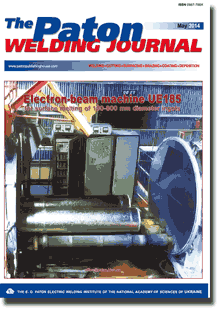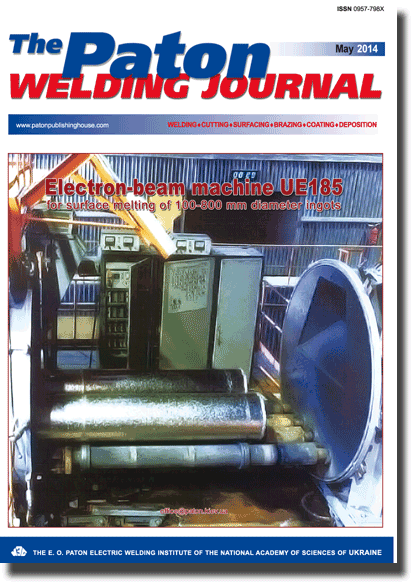| 2014 №05 (07) |
DOI of Article 10.15407/tpwj2014.05.08 |
2014 №05 (01) |

The Paton Welding Journal, 2014, #5, 48-51 pages
ASSESSMENT OF EFFECTIVENESS OF RESIDUAL STRESS LOWERING IN CIRCUMFERENTIAL JOINTS OF PIPES AFTER POSTWELD EXPLOSION TREATMENT
A.G. BRYZGALIN
E.O. Paton Electric Welding Institute, NASU. 11 Bozhenko Str., 03680, Kiev, Ukraine. E-mail: office@paton.kiev.ua
Abstract
It is established that at application of earlier developed procedure of calculation of explosion treatment modes for pipe circumferential joints the extent of residual stress lowering depends on their initial level. In particular, at explosion treatment of pipes without the circumferential weld the induced compressive stresses are essentially lower than welding stresses, whereas the latter are practically completely relieved at treatment of welds of similar pipes by the same modes. Scatter of induced compressive stresses in pipes of different typesizes did not exceed the measurement error. Dependence of explosion treatment effectiveness on the magnitude of initial welding stresses was determined, which is of a nonlinear nature. Presence of such a dependence allows prediction of treatment results and correction of modes depending on requirements made of treatment results. Fundamental difference of the mechanisms of residual stress lowering at heat treatment and explosion treatment is shown. 9 Ref., 2 Tables, 4 Figures.
Keywords: effectiveness, explosion treatment, heat treatment, residual stresses, deformations, circumferential weld, pipelines
Received: 27.01.14
Published: 28.05.14
References
1. Bryzgalin, A.G. (2013) Calculation of parameters of explosion treatment for reduction of residual stresses in circumferential welds of pipelines. The Paton Welding J., 8, 31-36.
2. Zubchenko, A.S., Koloskov, M.M., Amelianchik, A.V. et al. (2002) Investigation of effect of deformation treatment on residual stresses in circumferential welds. Ibid., 1, 2-9.
3. Kasatkin, B.S., Prokhorenko, V.M., Chertov, I.M. (1987) Stresses and strains in welding. Kiev: Vyshcha Shkola.
4. Lobanov, L.M., Pavlovsky, V.I., Lysak, V.V. (1989) Application of preliminary elastic deformation for control of stress-strain state in welding of thin-sheet structures from aluminium alloys. In: Welding of non-ferrous metals. Kiev: Naukova Dumka, 52-56.
5. SNiP III-42-80: Rules for performance and acceptance of works. Main gas pipelines. Moscow: Strojizdat.
6. Perunov, B.V., Kushnarenko, V.M. (1983) Corrosion prevention as a guarantee of efficiency. Chelyabinsk: YuUKI.
7. Dobrushin, L.D., Effendiev, E.E., Bryzgalin, A.G. (1985) Investigation of comparative efficiency of residual stress relaxation in circumferential welds of pipes from controlled rolling steel using explosion treatment. In: Application of explosion energy in welding technique. Kiev: PWI, 90-94.
8. Rabotnov, Yu.N. (1963) Strength of materials. Moscow: Fizmatgiz.
9. Makhnenko, V.I. (1976) Stress state in zones of circumferential butt joints of pipes during explosion treatment. In: Calculation methods for examination of kinetics of welding stresses and strains. Kiev: Naukova Dumka, 291-296.
Suggested Citation
A.G. BRYZGALIN (2014) ASSESSMENT OF EFFECTIVENESS OF RESIDUAL STRESS LOWERING IN CIRCUMFERENTIAL JOINTS OF PIPES AFTER POSTWELD EXPLOSION TREATMENT. The Paton Welding J., 05, 48-51.The cost of subscription/purchase order journals or individual articles
| Journal/Currency | Annual Set | 1 issue printed |
1 issue |
one article |
| TPWJ/USD | 384 $ | 32 $ | 26 $ | 13 $ |
| TPWJ/EUR | 348 € | 29 € | 24 € | 12 € |
| TPWJ/UAH | 7200 UAH | 600 UAH | 600 UAH | 280 UAH |
| AS/UAH | 1800 UAH | 300 UAH | 300 UAH | 150 UAH |
| AS/USD | 192 $ | 32 $ | 26 $ | 13 $ |
| AS/EUR | 180 € | 30 € | 25 € | 12 € |
| SEM/UAH | 1200 UAH | 300 UAH | 300 UAH | 150 UAH |
| SEM/USD | 128 $ | 32 $ | 26 $ | 13 $ |
| SEM/EUR | 120 € | 30 € | 25 € | 12 € |
| TDNK/UAH | 1200 UAH | 300 UAH | 300 UAH | 150 UAH |
| TDNK/USD | 128 $ | 32 $ | 26 $ | 13 $ |
| TDNK/EUR | 120 € | 30 € | 25 € | 15 € |
AS = «Automatic Welding» - 6 issues per year;
TPWJ = «PATON WELDING JOURNAL» - 12 issues per year;
SEM = «Electrometallurgy Today» - 4 issues per year;
TDNK = «Technical Diagnostics and Non-Destructive Testing» - 4 issues per year.


